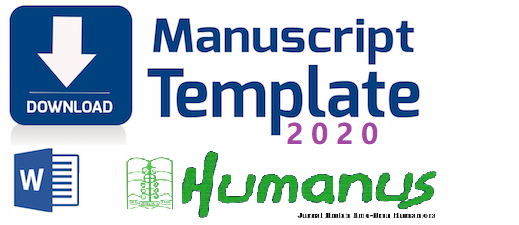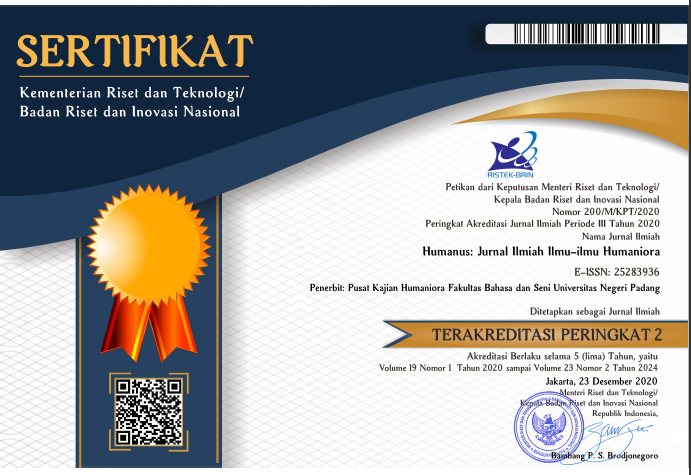Phonological and Morphological Factors of Indonesian Children's Stuttering
 ), Dadang Sudana(2), Anisa Arianingsih(3), Neidya Fatma Sunendar(4), Aceng Ruhendi Saifullah(5),
), Dadang Sudana(2), Anisa Arianingsih(3), Neidya Fatma Sunendar(4), Aceng Ruhendi Saifullah(5), (1) Universitas Pendidikan Indonesia, Indonesia
(2) Universitas Pendidikan Indonesia, Indonesia
(3) Universitas Komputer, Indonesia
(4) Universitas Pendidikan Indonesia, Indonesia
(5) Universitas Pendidikan Indonesia
 Corresponding Author
Corresponding Author
Copyright (c) 2023 Reny Rahmalina, Aceng RuhendI Saifullah, Wawan Gunawan, Nuria Haristiani, Dadang Sudana, Anisa Arianingsih
DOI : https://doi.org/10.24036/humanus.v22i2.125926
Full Text:
 Language : en
Language : en
Abstract
Keywords
References
Alqhazo, M., & Al-Dennawi, S. (2018). The linguistic aspects of the speech of Jordanian children who stutter. International Journal of Pediatric Otorhinolaryngology, 109, 174–179. https://doi.org/10.1016/j.ijporl.2018.04.003
Alqhazo, M., & Alfwaress, F. (2022). Stuttering frequency on content and function words in pre- and -age Jordanian Arabic-speaking children who stutter. Psychology of Language and Communication, 26(1), 1–17. https://doi.org/10.2478/plc-2022-0001
Aryal, D., & Maruthy, S. (2022). Linguistic factors and stuttering in Nepali-speaking adults who stutter. Clinical Linguistics & Phonetics, 1–14. https://doi.org/10.1080/02699206.2022.2049880
Aslam, M. (2021). Analysing Gray Cast Iron Data using a New Shapiro-Wilks test for Normality under Indeterminacy. International Journal of Cast Metals Research, 34(1), 1–5. https://doi.org/10.1080/13640461.2020.1846959
Brundage, S. B., & Bernstein Ratner, N. (2022). Linguistic Aspects of Stuttering. Topics in Language Disorders, 42(1), 5–23. https://doi.org/10.1097/TLD.0000000000000269
Chang, S. E., Garnett, E. O., Etchell, A., & Chow, H. M. (2019). Functional and Neuroanatomical Bases of Developmental Stuttering: Current Insights. Neuroscientist, 25(6), 566–582. https://doi.org/10.1177/1073858418803594
Choi, D., Sim, H., Park, H., Clark, C. E., & Kim, H. (2020). Loci of stuttering of English- and Korean-speaking children who stutter: Preliminary findings. Journal of Fluency Disorders, 64(October 2019), 105762. https://doi.org/10.1016/j.jfludis.2020.105762
Chon, H. (2021). Comparing Phonetic Complexity between Fluent and Disfluent Eojeols in Adults Who Stutter. Audiology and Speech Research, 17(1), 52–59. https://doi.org/10.21848/asr.200089
Choo, A. L., Greenberg, D., Li, H., & Talwar, A. (2023). Rate of Stuttering and Factors Associated With Speech Fluency Characteristics in Adult Struggling Readers. Journal of Learning Disabilities, 56(1), 7–24. https://doi.org/10.1177/00222194221095265
Didirkova, I., Maguer, S. Le, Hirsch, F., Gbedahou, D., Didirkova, I., Maguer, S. Le, Hirsch, F., & Be-, D. G. A. (2019). Articulatory Behaviour During Disfluencies in Stuttered Speech. International Congress on Phonetic Sciences, 1–5.
Farazi, M., Hosseini Dastgerdi, Z., & Khavarghazalani, B. (2022). What is the role of auditory processing in stuttering? A mini-review of previous knowledge. Hearing, Balance and Communication, 20(1), 1–7. https://doi.org/10.1080/21695717.2022.2033469
Hosseini, R., Walsh, B., Tian, F., & Wang, S. (2018). An fNIRS-based feature learning and classification framework to distinguish hemodynamic patterns in children who stutter. IEEE Transactions on Neural Systems and Rehabilitation Engineering, 26(6), 1254–1263. https://doi.org/10.1109/TNSRE.2018.2829083
Howland, C., Baker, E., Munro, N., & McLeod, S. (2019). Realization of grammatical morphemes by children with phonological impairment. Clinical Linguistics and Phonetics, 33(1–2), 20–41. https://doi.org/10.1080/02699206.2018.1518487
Iimura, D., Takahashi, S., Fukazawa, N., Morita, N., Oe, T., & Miyamoto, S. (2021). Effect of linguistic factors on the occurrence of stuttering-like disfluency among Japanese-speaking children who stutter. Clinical Linguistics & Phonetics, 1–16. https://doi.org/10.1080/02699206.2021.2001048
Kang, L., Riba, P., Wang, Y., Rusiñol, M., Fornés, A., & Villegas, M. (2020). GANwriting: Content-Conditioned Generation of Styled Handwritten Word Images (pp. 273–289). https://doi.org/10.1007/978-3-030-58592-1_17
Kant, A. R., & Disabilities, H. (2018). 4 . Sinha , A . K . and Kant , A . ( 2016 ). Development of a Digital-based Test of Articulation in Marathi, Journal of Communication Disorders of AYJNISHD ( D ), DEVELOPMENT OF A DIGITAL BASED TEST OF ARTICULATION IN MARATHI AUTHORS : Anjali R . Kant Reader and Head of Department Speech and Language Pathology, AYJNISHD ( D ), Mumbai Dr . Ashok Kumar Sinha, AYJNISHD ( D ), Mumbai. 1(January 2016).
Khasawneh, M. A. S. (2021). The level of stuttering severity among students with learning disabilities in the English language. Science and Education, 2(9), 215–224. https://cyberleninka.ru/article/n/the-level-of-stuttering-severity-among-students-with-learning-disabilities-in-english-language
Kim, N., Patel, R., Poliak, A., Wang, A., Xia, P., McCoy, R. T., Tenney, I., Ross, A., Linzen, T., Van Durme, B., Bowman, S. R., & Pavlick, E. (2019). Probing what different NLP tasks teach machines about function word comprehension. *SEM@NAACL-HLT 2019 - 8th Joint Conference on Lexical and Computational Semantics, 235–249. https://doi.org/10.18653/v1/s19-1026
Lago, S., Mosca, M., & Stutter Garcia, A. (2021). The Role of Crosslinguistic Influence in Multilingual Processing: Lexicon Versus Syntax. Language Learning, 71(March), 163–192. https://doi.org/10.1111/lang.12412
Li, X., Song, D., Zhang, P., Zhang, Y., Hou, Y., & Hu, B. (2018). Exploring EEG features in cross-subject emotion recognition. Frontiers in Neuroscience, 12(MAR). https://doi.org/10.3389/fnins.2018.00162
Lu, Y., Wiltshire, C. E. E., Watkins, K. E., Chiew, M., & Goldstein, L. (2022). Characteristics of articulatory gestures in stuttered speech: A case study using real-time magnetic resonance imaging. Journal of Communication Disorders, 97, 106213. https://doi.org/10.1016/j.jcomdis.2022.106213
Manipuspika, Y. S., Sudarwati, E., Astuti, Y., & Indhiarti, T. R. (2022). Current Trends and Issues on Linguistics and Language Teaching Research. Universitas Brawijaya Press.
Mohajeri Aval, N. (2021). The Effectiveness of Transcranial Direct Current Stimulation (tDCS) on Improving the Severity of Stuttering and Anxiety in -aged Children Who Stutter. Journal of Practice in Clinical Psychology, 9(3), 227- 236. https://doi.org/10.32598/jpcp.9.3.761.1
Nayeb, L., Lagerberg, D., Westerlund, M., Sarkadi, A., Lucas, S., & Eriksson, M. (2019). Modifying a language screening tool for three-year-old children identified with severe language disorders six months earlier. Acta Paediatrica, International Journal of Paediatrics, 108(9), 1642–1648. https://doi.org/10.1111/apa.14790
Pathak, A., Calvert, G. A., & Lim, L. K. S. (2020). Harsh voices, sound branding: How voiced consonants in a brand’s name can alter its perceived attributes. Psychology and Marketing, 37(6), 837–847. https://doi.org/10.1002/mar.21346
Preston, R., Halpin, M., Clarke, G., & Millard, S. (2022). Palin parent-child interaction therapy with children with autism spectrum disorder and stuttering. Journal of Communication Disorders, 97, 106217. https://doi.org/10.1016/j.jcomdis.2022.106217
Salvago, P., Gorgone, E., Giaimo, S., Battaglia, E., Dispenza, F., Ferrara, S., & Martines, F. (2019). Is there an association between age at first words and speech sound disorders among 4- to 5-year-old children? An epidemiological cross-sectional study based on parental reports. International Journal of Pediatric Otorhinolaryngology, 126, 109602. https://doi.org/10.1016/j.ijporl.2019.109602
Saragih, A. D. (2018). Analisis Bahasa Anak Yang Mengalami Gangguan Kelancaran Berbicara (Gagap). Universitas Muhammadiyah Sumatera Utara.
Sari, H., Gökdağ, H., & Kizilkaya, H. (2019). Evaluating Teachers’ Opinions on Learning Difficulties of Stuttering Primary Students In Terms of Terms of First Literacy. Journal of Modern Science, 42(3), 57–81. https://doi.org/10.13166/jms/112280
Seth, D., & Maruthy, S. (2019). Effect of phonological and morphological factors on speech disfluencies of Kannada speaking children who stutter. Journal of Fluency Disorders, 61, 105707. https://doi.org/10.1016/j.jfludis.2019.105707
Singer, C. M., Hessling, A., Kelly, E. M., Singer, L., & Jones, R. M. (2020). Clinical Characteristics Associated With Stuttering Persistence: A Meta-Analysis. Journal of Speech, Language, and Hearing Research, 63(9), 2995–3018. https://doi.org/10.1044/2020_JSLHR-20-00096
Sugathan, N., & Maruthy, S. (2021). Predictive factors for persistence and recovery of stuttering in children: A systematic review. International Journal of Speech-Language Pathology, 23(4), 359–371. https://doi.org/10.1080/17549507.2020.1812718
Tahmasebi, N., Shafie, B., Karimi, H., & Mazaheri, M. (2018). A Persian version of the stuttering severity instrument-version four (SSI-4): How do the new additions to SSI-4 complement its stuttering severity score? Journal of Communication Disorders, 74(April), 1–9. https://doi.org/10.1016/j.jcomdis.2018.04.005
Usler, E. R. (2022). Why Stuttering Occurs. Topics in Language Disorders, 42(1), 24–40. https://doi.org/10.1097/TLD.0000000000000275
Wahyuningsih, S., & Afandi, M. (2020). Investigating English speaking problems: Implications for speaking curriculum development in Indonesia. European Journal of Educational Research, 9(3), 967–977. https://doi.org/10.12973/EU-JER.9.3.967
Weidner, M. E., St. Louis, K. O., & Glover, H. L. (2018). Changing nonstuttering children's stuttering attitudes. American Journal of Speech-Language Pathology, 27(4), 1445–1457. https://doi.org/10.1044/2018_AJSLP-18-0019
 Article Metrics
Article Metrics
 Abstract Views : 198 times
Abstract Views : 198 times
 PDF Downloaded : 70 times
PDF Downloaded : 70 times
Refbacks
- There are currently no refbacks.
Copyright (c) 2023 Reny Rahmalina, Aceng RuhendI Saifullah, Wawan Gunawan, Nuria Haristiani, Dadang Sudana, Anisa Arianingsih

This work is licensed under a Creative Commons Attribution-NonCommercial 4.0 International License.










